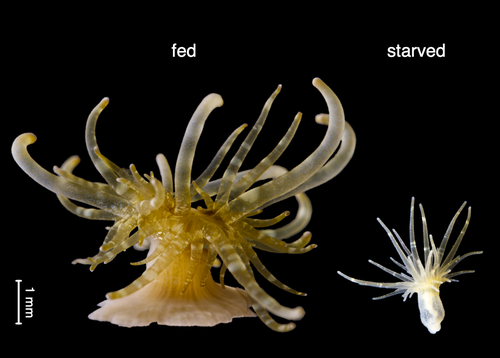
Constraining the importance of heterotrophic vs autotrophic feeding in photosymbiotic cnidarians
 based on reviews by 2 anonymous reviewers
based on reviews by 2 anonymous reviewers

Symbiotic nutrient cycling enables the long-term survival of Aiptasia in the absence of heterotrophic food sources
Abstract
Recommendation: posted 11 May 2023, validated 13 May 2023
Cardini, U. (2023) Constraining the importance of heterotrophic vs autotrophic feeding in photosymbiotic cnidarians. Peer Community in Ecology, 100520. https://doi.org/10.24072/pci.ecology.100520
Recommendation
The symbiosis with autotrophic dinoflagellate algae has enabled heterotrophic Cnidaria to thrive in nutrient-poor tropical waters (Muscatine and Porter 1977; Stanley 2006). In particular, mixotrophy, i.e. the ability to acquire nutrients through both autotrophy and heterotrophy, confers a competitive edge in oligotrophic waters, allowing photosymbiotic Cnidaria to outcompete benthic organisms limited to a single diet (e.g., McCook 2001). However, the relative importance of autotrophy vs heterotrophy in sustaining symbiotic cnidarian’s nutrition is still the subject of intense research. In fact, figuring out the cellular mechanisms by which symbiotic Cnidaria acquire a balanced diet for their metabolism and growth is relevant to our understanding of their physiology under varying environmental conditions and in response to anthropogenic perturbations.
In this study's long-term starvation experiment, Radecker & Meibom (2023) investigated the survival of the photosymbiotic sea anemone Aiptasia in the absence of heterotrophic feeding. After one year of heterotrophic starvation, Apitasia anemones remained fully viable but showed an 85 % reduction in biomass. Using 13C-bicarbonate and 15N-ammonium labeling, electron microscopy and NanoSIMS imaging, the authors could clearly show that the contribution of algal-derived nutrients to the host metabolism remained unaffected as a result of increased algal photosynthesis and more efficient carbon translocation. At the same time, the absence of heterotrophic feeding caused severe nitrogen limitation in the starved Apitasia anemones.
Overall, this study provides valuable insights into nutrient exchange within the symbiosis between Cnidaria and dinoflagellate algae at the cellular level and sheds new light on the importance of heterotrophic feeding as a nitrogen acquisition strategy for holobiont growth in oligotrophic waters.
REFERENCES
McCook L (2001) Competition between corals and algal turfs along a gradient of terrestrial influence in the nearshore central Great Barrier Reef. Coral Reefs 19:419–425. https://doi.org/10.1007/s003380000119
Muscatine L, Porter JW (1977) Reef corals: mutualistic symbioses adapted to nutrient-poor environments. Bioscience 27:454–460. https://doi.org/10.2307/1297526
Radecker N, Meibom A (2023) Symbiotic nutrient cycling enables the long-term survival of Aiptasia in the absence of heterotrophic food sources. bioRxiv, ver. 3 peer-reviewed and recommended by Peer Community in Ecology. https://doi.org/10.1101/2022.12.07.519152
Stanley GD Jr (2006) Photosymbiosis and the evolution of modern coral reefs. Science 312:857–858. https://doi.org/10.1126/science.1123701
The recommender in charge of the evaluation of the article and the reviewers declared that they have no conflict of interest (as defined in the code of conduct of PCI) with the authors or with the content of the article. The authors declared that they comply with the PCI rule of having no financial conflicts of interest in relation to the content of the article.
N.R. and A.M. are supported by the Swiss National Science Foundation, grants 200021_179092 and 205321_212614
Evaluation round #2
DOI or URL of the preprint: https://doi.org/10.1101/2022.12.07.519152
Version of the preprint: 2
Author's Reply, 05 May 2023
Dear Ulisse,
we were delighted to hear that our manuscript is ready for recommendation.
We have revised the remaining minor edits according to the suggestions of reviewer 1.
We would like to thank you and the reviewers for the constructive feedback and the interest expressed in our work.
Sincerely,
Anders & Nils
PS: Apologies for the poor figure quality in the track changes document. But file size limits required PDF compression resulting in quality loss. For the high-quality figures, please refer to the biorxivs submission.
Decision by Ulisse Cardini , posted 02 May 2023, validated 02 May 2023
, posted 02 May 2023, validated 02 May 2023
Dear Nils,
Thank you for submitting your preprint article "Symbiotic nutrient cycling enables the long-term survival of Aiptasia in the absence of heterotrophic food sources" to PCI Ecology. Following careful assessment of your submission, two expert reviewers feel that it is ready for recommendation, pending two minor comments.
Congratulations on your interesting contribution to the field! I am ready to write a recommendation text of your article as soon as these remaining minor comments are addressed.
Please feel free to contact me with any questions.
Sincerely,
Ulisse Cardini
Reviewed by anonymous reviewer 1, 18 Apr 2023
Reviewed by anonymous reviewer 2, 02 May 2023
The authors correctly addressed all comments. I would like to congratulate the authors on the SEM-NanoSIMS correlation.
As far as I am concerned, the paper is ready for publication.
Kind regards,
https://doi.org/10.24072/pci.ecology.100520.rev22Evaluation round #1
DOI or URL of the preprint: https://doi.org/10.1101/2022.12.07.519152
Version of the preprint: 1
Author's Reply, 28 Mar 2023
Decision by Ulisse Cardini , posted 23 Jan 2023, validated 23 Jan 2023
, posted 23 Jan 2023, validated 23 Jan 2023
Dear Nils,
Thank you for submitting your preprint article "Symbiotic nutrient cycling enables the long-term survival of Aiptasia in the absence of heterotrophic food sources" to PCI Ecology. Following careful assessment of your submission, two expert reviewers feel that it has potential for recommendation, so we would like to invite you to revise the paper following their comments.
Please see the attached reviewer comments for further details about necessary revisions.
We ask that you submit the revised version of your manuscript by February 27, but please let me know if you need more time. Your revised manuscript should be accompanied by a summary of how you responded to the reviewers' comments.
Please feel free to contact me with any questions.
Sincerely,
Ulisse Cardini










